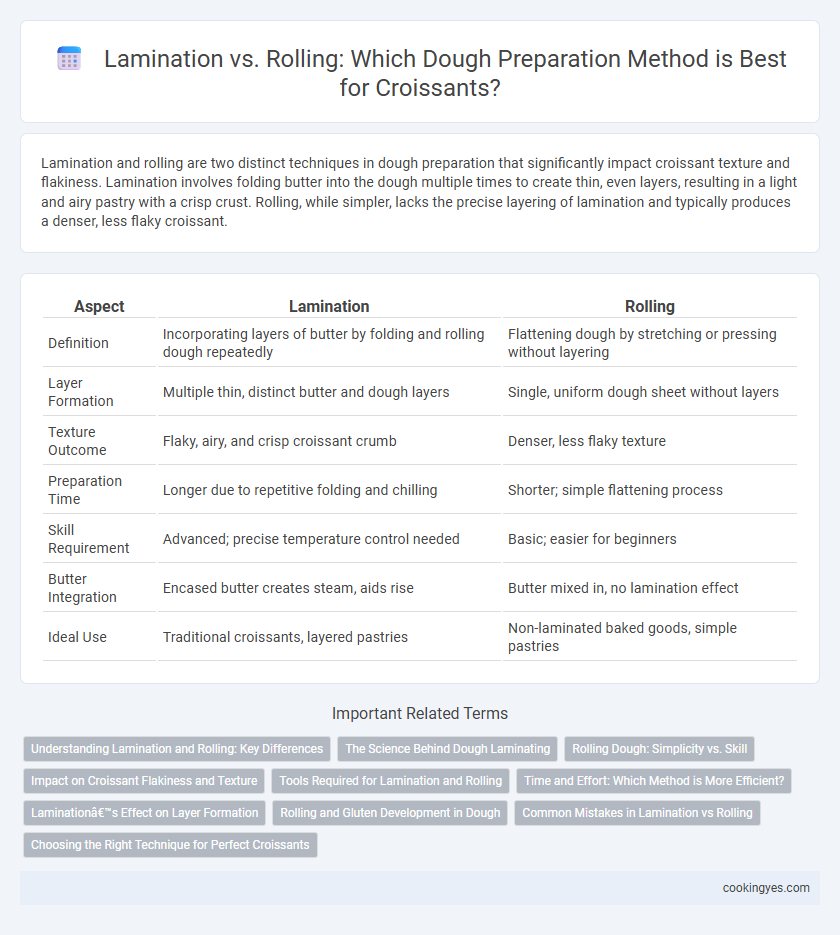Lamination and rolling are two distinct techniques in dough preparation that significantly impact croissant texture and flakiness. Lamination involves folding butter into the dough multiple times to create thin, even layers, resulting in a light and airy pastry with a crisp crust. Rolling, while simpler, lacks the precise layering of lamination and typically produces a denser, less flaky croissant.
Table of Comparison
| Aspect | Lamination | Rolling |
|---|---|---|
| Definition | Incorporating layers of butter by folding and rolling dough repeatedly | Flattening dough by stretching or pressing without layering |
| Layer Formation | Multiple thin, distinct butter and dough layers | Single, uniform dough sheet without layers |
| Texture Outcome | Flaky, airy, and crisp croissant crumb | Denser, less flaky texture |
| Preparation Time | Longer due to repetitive folding and chilling | Shorter; simple flattening process |
| Skill Requirement | Advanced; precise temperature control needed | Basic; easier for beginners |
| Butter Integration | Encased butter creates steam, aids rise | Butter mixed in, no lamination effect |
| Ideal Use | Traditional croissants, layered pastries | Non-laminated baked goods, simple pastries |
Understanding Lamination and Rolling: Key Differences
Lamination involves folding butter into dough multiple times to create distinct, flaky layers essential for croissant texture, while rolling simply flattens the dough without incorporating layers. The lamination process develops the characteristic airy and tender crumb by trapping steam between butter layers during baking. Rolling is typically used for simpler doughs where layering is not required, resulting in denser pastries compared to laminated croissant dough.
The Science Behind Dough Laminating
Lamination in croissant dough involves folding butter into dough multiple times to create thin, distinct layers that trap steam during baking, producing a flaky texture. This process relies on the principle of gluten network formation and steam expansion, which contributes to the dough's rise and delicate crumb structure. Rolling alone lacks the intricate layering necessary to achieve the characteristic lightness and crispness of a perfectly laminated croissant.
Rolling Dough: Simplicity vs. Skill
Rolling dough for croissant preparation offers a straightforward technique that requires minimal equipment, making it accessible for home bakers. Although rolling is simpler compared to lamination, it demands precise control of dough thickness and consistency to achieve the desired flaky texture. Successful rolling depends on skillful handling to evenly distribute butter without compromising dough elasticity, ensuring optimal rise and layers in the final croissant.
Impact on Croissant Flakiness and Texture
Lamination involves folding butter into dough multiple times, creating thin alternating layers that produce the signature flaky texture of croissants by trapping steam during baking. Rolling alone without proper lamination results in a denser crumb and less distinct layers, reducing the lightness and flakiness characteristic of high-quality croissants. The controlled lamination process directly impacts the croissant's airy structure, crisp outer crust, and delicate, buttery layers.
Tools Required for Lamination and Rolling
Lamination requires specialized tools such as a rolling pin, dough scraper, and a chilled surface to create multiple layers of butter and dough essential for flaky croissants. Rolling for general dough preparation typically involves just a rolling pin and a flat work surface, without the need for temperature control or precision layering tools. Precision in lamination tools ensures proper butter distribution, crucial for croissant texture, whereas rolling focuses on evenly flattening the dough for initial shaping.
Time and Effort: Which Method is More Efficient?
Lamination involves folding and layering dough with butter multiple times to create flaky croissant layers, requiring significant time and skill to achieve perfect texture. Rolling is a simpler, quicker process but lacks the multiple buttery layers essential for traditional croissants, resulting in less flakiness. For efficient croissant dough preparation, lamination is more time-consuming but yields superior quality, while rolling offers faster but less authentic results.
Lamination’s Effect on Layer Formation
Lamination in croissant dough preparation involves folding and rolling butter into the dough multiple times, creating thin, alternating layers of butter and dough that expand during baking to form a flaky texture. This process ensures distinct, well-defined layers that trap steam, contributing to the characteristic airy and crisp structure of a croissant. In contrast, simple rolling lacks the repeated folding necessary for optimal layer development, resulting in a denser crumb.
Rolling and Gluten Development in Dough
Rolling in croissant dough preparation plays a crucial role in gluten development, creating layers that contribute to the pastry's flakiness and structure. The repeated folding and rolling process strengthens gluten strands, enhancing elasticity and dough strength, which is essential for trapping steam during baking. Proper rolling technique ensures the dough achieves the optimal balance between elasticity and extensibility, resulting in a tender yet flaky croissant texture.
Common Mistakes in Lamination vs Rolling
Common mistakes in lamination include uneven butter distribution leading to inconsistent flakiness and dough tearing from overworking or insufficient chilling. Rolling errors often involve applying excessive pressure, causing butter leakage and a dense crumb texture instead of delicate layers. Proper temperature control and uniform technique are critical to achieving the signature lamination structure in croissant dough.
Choosing the Right Technique for Perfect Croissants
Lamination involves folding and rolling butter into dough multiple times to create distinct flaky layers essential for classic croissants, while rolling is a simpler method with less layering and a denser texture. For perfectly airy, buttery croissants, lamination is the preferred technique as it develops the signature delicate, crispy crust and tender crumb. Mastery of lamination ensures optimal butter distribution, dough elasticity, and consistent rise, critical factors for professional-quality croissants.
Lamination vs Rolling for Dough Preparation Infographic

 cookingyes.com
cookingyes.com